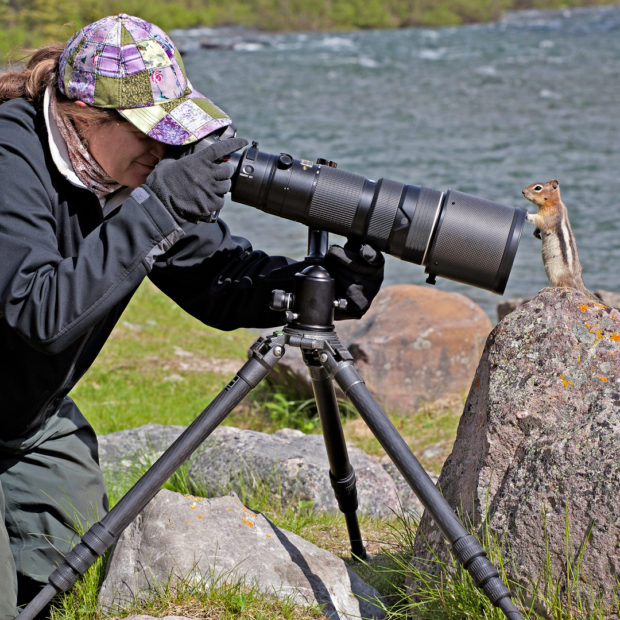We have much more to do and your continued support is needed now more than ever.
4 Social Media Strategies to Help You Land that Dream Green Job
This article is the second in a series by the National Wildlife Federation EcoLeaders Career Center Fellow, Elizabeth Morgan. Elizabeth will be covering various green career topics in advance of the inaugural NWF EcoCareer Conference, occurring online this February 22 and 23, 2017. Registration is free for members of the EcoLeaders community (also free!).
 Social media can both help and hurt you in the job search process. It is a great tool to help you find and learn more about potential employers, including identifying connections to people at those organizations and finding people you may already know. Social media can also hurt your search if you aren’t careful about what you make public information (especially pictures you may be tagged in on your friend’s Facebook page!). Check to see what’s publicly visible on a regular basis by searching for yourself on Google and by viewing the public version of your Facebook profile.
Social media can both help and hurt you in the job search process. It is a great tool to help you find and learn more about potential employers, including identifying connections to people at those organizations and finding people you may already know. Social media can also hurt your search if you aren’t careful about what you make public information (especially pictures you may be tagged in on your friend’s Facebook page!). Check to see what’s publicly visible on a regular basis by searching for yourself on Google and by viewing the public version of your Facebook profile.
1) Personal Branding
Columbia University (CU) recommends advertising your personal brand using social media while job searching. Social media allows you to demonstrate your talents, values, and professionalism to employers passively. A 2009 Career Builder survey found that 45% of employers use social media to screen potential applicants for a position. If a potential employer searches for your social media presence, you want it to be easily accessible, demonstrate your social media savvy, and market yourself via personal branding.
CU suggests a five-step exercise to help you create your personal brand. As an example, I have provided some preliminary answers based on my own interests and branding:
Step 1: Identify 5 organizational brands that inspire you, and write them down.
- National Wildlife Federation (NWF), U.S. Fish and Wildlife Service (USFWS), Nature Conservancy, National Geographic, The Wildlife Society
Step 2: Write specific attributes of each brand that you like.
- NWF: a large nonprofit organization, focus on wildlife and habitat protection, federation structure with state affiliates, educational programs, advocacy, beautiful wildlife photography, etc.
- USFWS: federal agency, focus on wildlife and habitat protection, etc.
- (repeat for each)
Step 3: Circle or identify themes across all five brands.
- Some of the themes that I identified across all five are: environmental and wildlife education, social media marketing and incredible imagery, focus on advancing and supporting scientific solutions, collaborative organizations, habitat protection and restoration work, etc.
Step 4: The traits that come up repeatedly are your personal brand values.
- My personal brand values include: a passion for environmental education and habitat land management on a national scale, bringing this passion to others through wildlife photography, stories, and advocacy, etc.
Step 5: Write down a few ways you could advertise these personal brand values through social media to advance your job search.
- Some strategies for me could include: joining science-based sustainability groups on LinkedIn, following and posting wildlife photography with educational information and opportunities to act on Instagram, and following and sharing advancements in wildlife research and habitat management on Facebook.

2) Optimize Your LinkedIn Profile
LinkedIn has fantastic, free resources specifically for recent graduates. I found the “college student” profile checklist to be really helpful. Additionally, LinkedIn recommends that you:
- Have a complete profile including major accomplishments, experiences, volunteer work, and any other professional achievements
- Include recommendations from previous supervisors and co-workers
- Make connections to friends, family, alumni, and past and present colleagues and supervisors
- Join LinkedIn groups that align with your professional interests, and organizations you are already a member of
- Follow companies and organizations that you are interested in
3) Connect Your Resume to Your LinkedIn Profile
One quick way to up your social media savvy is to add both a hyperlink and a “Quick Response” (QR) code to your resume or cover letter that connects directly to your LinkedIn profile. Attaching a QR code to your resume and/or cover letter is a great way for you to stand out from the competition and quickly offer more information about yourself to a potential employer that you may meet at a networking event or at a career fair. Here is a great article that includes a “how to.”
4) Develop and Share Your Elevator Speech
Most social media platforms include a section to post a short bio; use this opportunity to share your personal “elevator speech.”
 What is an elevator speech? An elevator speech is essentially a 15-30 second “commercial” about yourself. The idea is to succinctly communicate who you are and what you are looking for in the time it takes people to share an elevator ride between floors of a building (preferably to the top floor to give you more time!). Idealist recommends trying to address four key priorities by answering these questions: (1) skills; what do you do well? what are your professional accomplishments or transferable skills? (2) confidence; what is your greatest strength in this area or the best compliment you’ve ever received about your skill? (3) goals; what would you like to do? (4) motivation; what’s your “why”?
What is an elevator speech? An elevator speech is essentially a 15-30 second “commercial” about yourself. The idea is to succinctly communicate who you are and what you are looking for in the time it takes people to share an elevator ride between floors of a building (preferably to the top floor to give you more time!). Idealist recommends trying to address four key priorities by answering these questions: (1) skills; what do you do well? what are your professional accomplishments or transferable skills? (2) confidence; what is your greatest strength in this area or the best compliment you’ve ever received about your skill? (3) goals; what would you like to do? (4) motivation; what’s your “why”?
So, if we were to meet on the elevator, my quick speech would go something like, “My name is Elizabeth Morgan; I’m a California native that recently moved to Denver, Colorado to study public administration specializing in nonprofit management at the University of Colorado. I have a strong knack for organizational management and effective communication, which has made me a successful leader in planning fundraising events for multiple nonprofit organizations. My passion for wildlife conservation drives me to pursue a career in nonprofit management involved in environmental education, public land management, and conservation advocacy. I hope to use my career to enhance wildlife populations across the globe.”
Social media can be a leverage or can hinder your career. You control how you reflect yourself online, so having professional and interesting pages will help you move up in your career. Comment here or in the EcoLeaders forums to share your favorite social media tips!
Want even more tips for an exciting green career?
Mark Your CalendarDon’t forget to register for NWF’s virtual EcoCareer Conference, February 22 and 23, 2017.






















